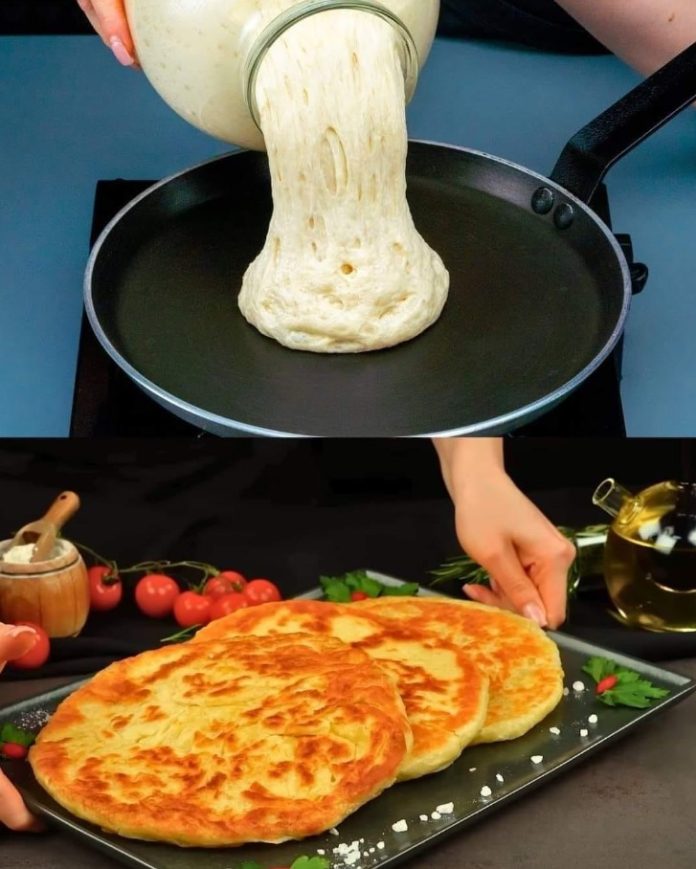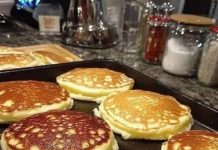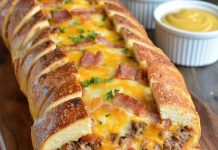There’s something truly special about homemade bread. It carries the warmth of the kitchen and the love of a meal made from scratch. This homemade soft flatbread is a wonderful way to enjoy the taste and aroma of freshly baked bread without the need for complex equipment or techniques. Whether you serve it as a side, use it as a base for various toppings, or simply enjoy it on its own, this flatbread recipe is a delicious addition to any meal.
In this article, we’ll guide you through a straightforward recipe for making soft, golden flatbreads right in your own kitchen. From preparing the dough to the final golden product, you’ll find all the steps you need to create this delightful bread.
Ingredients :
- 2 cups all-purpose flour
- 1 tablespoon granulated sugar
- 1 cup warm water
- 1 packet active dry yeast (2 1/4 teaspoons)
- 2 tablespoons olive oil (plus extra for cooking)
- 1 teaspoon salt
Optional Ingredients for Extra Flavor:
- Fresh or dried herbs (such as rosemary or thyme)
- Minced garlic
- Shredded cheese (such as cheddar or Parmesan)
Instructions :
Step 1: Prepare the Dough
- Activate the Yeast: In a small bowl, dissolve the granulated sugar in the warm water. Sprinkle the active dry yeast over the surface of the water and let it sit for about 5 to 10 minutes. You should see bubbles forming and the mixture becoming frothy, indicating that the yeast is active.
- Mix the Dough: In a large mixing bowl, combine the flour and salt. Make a well in the center and pour in the yeast mixture along with the olive oil. Stir the ingredients together until a soft dough forms. If you’re adding herbs, minced garlic, or cheese, fold them in at this stage.
- Knead and Rise: Transfer the dough onto a floured surface and knead it for about 5 to 7 minutes, or until it becomes smooth and elastic. Place the dough in a lightly oiled bowl, cover it with a clean cloth, and let it rise in a warm spot for about an hour, or until it has doubled in size.
Step 2: Shape and Cook the Flatbreads
- Prepare the Pan: Heat a skillet or a non-stick frying pan over medium heat. Add a small amount of olive oil to the pan and spread it evenly.
- Roll Out the Dough: Punch down the risen dough and divide it into smaller portions. Roll each portion into a flat circle, about 1/4 inch thick. Place the rolled dough into the heated skillet.
- Cook the Flatbreads: Cook each flatbread for 2 to 3 minutes on each side, or until golden brown and cooked through. The flatbread should have a slightly crisp exterior with a soft interior. Repeat with the remaining dough.
Step 3: Serve and Enjoy
- Cool and Serve: Once cooked, transfer the flatbreads to a plate and keep them warm. Serve them alongside your favorite dips, or use them as a base for sandwiches or pizzas.
Tips for Perfect Flatbread
- Maintain Medium Heat: To ensure even cooking and prevent burning, keep the skillet at medium heat.
- Experiment with Flavors: Try adding different herbs, minced garlic, or cheese to the dough to customize the flavor of your flatbreads.
- Storage: If you have leftover flatbreads, store them in an airtight container. You can reheat them in a skillet or a toaster for a quick refresh.
Conclusion :
Making your own soft flatbreads at home is a simple yet gratifying experience. With just a few basic ingredients and a little bit of time, you can create delicious, warm flatbreads that are perfect for any meal. Whether you’re serving them with a hearty stew, using them as a base for creative toppings, or simply enjoying them with a bit of butter, these flatbreads are sure to become a beloved part of your recipe repertoire.
So why not give this recipe a try? Indulge in the comfort and satisfaction of homemade bread, and experience the joy of baking from scratch. Your family and friends will appreciate the fresh, delightful taste of these soft flatbreads, and you’ll savor the process of creating something special in your own kitchen.
Source of the picture : Barbara O’Neill Lectures










